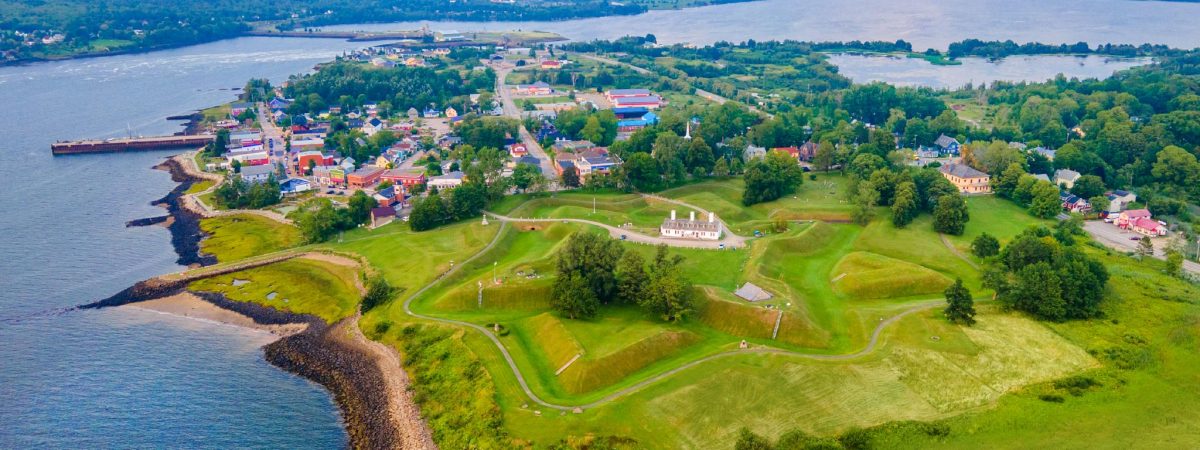History Timeline
Annapolis Royal and area play a special and unique role in Canadian history. The first permanent European settlement in North America north of St. Augustine, Florida, was established at Port Royal in 1605.
From that time until 1749, Port Royal, or Annapolis Royal, was frequently the military and administrative centre of Acadia or Nova Scotia, which covered a substantially larger area than the present Nova Scotia.
The founding people of Nova Scotia, there is evidence of the Mi’kmaq inhabiting Nova Scotia dating back 9,000 to 11,000 years ago
1604
Pierre de Gua, Sieur de Mons and Samuel Champlain, with a company of French explorers, investigate the Annapolis Basin.
1605
Sieur de Mons and Samuel Champlain establish Port Royal. The French, early on, establish excellent relations with the Mi’kMaq natives headed by Chief Membertou, a relationship which continues until 1763 when the Treaty of Paris is signed leaving England with control of all former French possessions in North America.
1606
M. Pontgrave builds the first ships in North America, a barque and a shallop. Samuel Champlain originates “l’ordre de bon temps” (The Order of Good Cheer), and M. Poutrincourt implements it at his table. Marc Lescarbot writes and produces The Theatre of Neptune.
1607
M. Poutrincourt establishes the first water-powered grist mill on the Lequille River (present day Allain’s River).
1610
Chief Membertou is baptized by Messire Josse Fleche.
1613
Captain Samuel Argall of the Virginia Settlement attacks and destroys Port Royal.
1621
King James I grants to Sir William Alexander all of Nova Scotia (which then included New Brunswick)
1622
Sir William sends a ship and some settlers who build a fort at Port Royal on the site of Fort Anne.
1629
Acadia is restored to France.
1632-1634
Charles de Menou, Sieur d’Aulnay de Charnisay moves settlers from LaHave to Port Royal (Annapolis Royal), and the Acadian people begin to establish their roots.
1654
Americans from Massachusetts under Colonel Sedgewick capture Port Royal, which then returns to the French in 1667. In a census taken in 1671 there are 361 Acadians in the Port Royal area.
1680
Port Royal is again captured by the Americans, but is probably returned within a year. Another census in 1686 shows 592 Acadians at Port Royal.
1690
Sir William Phipps, with troops from Boston, captures Port Royal, but again Acadia is returned to France quickly.
1706-1710
Men from Massachusetts attempt to capture Port Royal in 1707, but are rebuffed. In 1710, Colonel Francis Nicholson returns and is successful in capturing Port Royal, which is renamed Annapolis Royal.
1711
A detachment from Fort Anne goes upriver and is ambushed by a band of natives. Thirty soldiers including a major and fort engineer are killed at “Bloody Creek”, 12 miles east of Annapolis Royal.
1744
The priest Le Loutre leads a band of natives in an attack on the Fort and Annapolis Royal. Lieutenant Governor Mascarene has several buildings in the Town pulled down so that they will not provide shelter for the attackers.
1749
Annapolis Royal loses her status as capital of Nova Scotia, as Governor Cornwallis establishes Halifax as the new capital.
1755
About 1750 Acadians from the area are expelled from Nova Scotia. All of their homes and buildings are burned.
1760
The Charming Molly arrives in Annapolis Royal from Boston carrying 45 passengers, the first of many New England Planters who would be granted land and settle in Annapolis County.
1781-1783
About 2500 United Empire Loyalists, including a number of black families, disembark at Annapolis Royal.
1864
Rose Fortune dies. She was a black Loyalist who developed her own modest transportation system using a wheel barrow to transport goods, and who passed along the business to her descendants who expanded the business and operated it well into the 20th century. She also became the Town’s unofficial police officer.
1869
Annapolis Royal becomes the terminus of the Windsor & Annapolis Railway thus beginning a major era of growth in the Town and area. Shipbuilding, forestry and agriculture are prominent.
1891
The Railway is continued to Digby, and the growth begins to slow.
1900s
As steamships take over, the shipbuilding and other marine activities become history. Annapolis Royal and the surrounding communities become a quite rural area in which tourism provides a major economic activity.
1917
Fort Anne becomes Canada’s first National Historic Site. It develops as a museum and important local tourist attraction under the first superintendent, Loftus Morton Fortier. Fort Anne has been the site of fortifications from the time of the Scot’s Fort in 1629.
1939
Port Royal Habitation is re-constructed based on Champlain’s original plans for Port Royal in 1605.
1978-1982
Community leaders spearhead a period of restoration and development in Annapolis Royal. This period sees the restoration and rejuvenation of many heritage buildings, including King’s Theatre, along with the development of several new projects including the Historic Gardens, waterfront boardwalk and the Farmers & Traders Market.
1981
Daurene Lewis, descendant of Rose Fortune, is elected as the first black woman Mayor in Canada.
1984
North America’s first Tidal Power Generating Station is built on the Annapolis Causeway.
References:
1. A History of Nova Scotia, Beamish Murdoch, 1866
2. History of the County of Annapolis, WA Calnek, 1897







